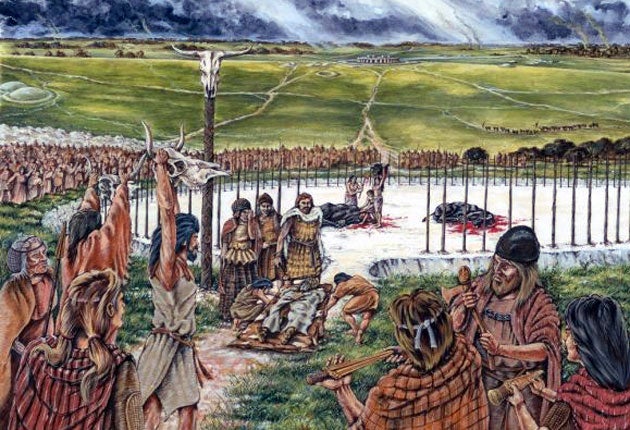Ancient royal tomb found in Scotland
Archaeologists stunned as dig unearths 4,000-year-old burial treasures unrivalled anywhere in Britain

Your support helps us to tell the story
From reproductive rights to climate change to Big Tech, The Independent is on the ground when the story is developing. Whether it's investigating the financials of Elon Musk's pro-Trump PAC or producing our latest documentary, 'The A Word', which shines a light on the American women fighting for reproductive rights, we know how important it is to parse out the facts from the messaging.
At such a critical moment in US history, we need reporters on the ground. Your donation allows us to keep sending journalists to speak to both sides of the story.
The Independent is trusted by Americans across the entire political spectrum. And unlike many other quality news outlets, we choose not to lock Americans out of our reporting and analysis with paywalls. We believe quality journalism should be available to everyone, paid for by those who can afford it.
Your support makes all the difference.Hidden beneath a four-ton slab of rock and surrounded by ancient carved symbols of prehistoric power, a spectacular high-status potentially royal tomb, dating back 4,000 years, has been discovered by archaeologists in Scotland.
The find – of international importance – is unique in Britain. The excavations at Forteviot, near Perth, have yielded the remains of an early Bronze Age ruler buried on a bed of white quartz pebbles and birch bark with at least a dozen personal possessions – including a bronze and gold dagger, a bronze knife, a wooden bowl and a leather bag.
The discovery has huge implications for Scottish history. Forteviot has long been known to have been a great royal centre in the early medieval period. It was a "capital" of a Pictish Kingdom in the 8/9th century AD – and one of Scotland's earliest kings, Kenneth MacAlpin, is said to have had a palace there.
But up until now nobody suspected that Forteviot's royal roots might be thousands of years older. The newly discovered prehistoric tomb is of particular importance because it lies at the very heart of Scotland's largest pre-historic ritual/religious ceremonial complex. The excavations are now revealing that back in around 2600 BC, local Neolithic people constructed a giant 250m diameter circle of 200 timber obelisks with a ceremonial processional way leading to its entrance and an inner timber circle at its centre. Each oak obelisk was up to a metre in diameter. Then, by 2400BC, a massive earthwork enclosure with a 10m wide, 3m deep moat was built inside that inner timber circle.
At roughly the same time two other similar earthwork enclosures – "henges" – were built, north of the large timber circle. And finally in around 2000BC the tomb was built underground in what was probably the most prestigious location – immediately opposite the entrance to the henge at the centre of the entire complex.
Uniquely, the tomb's stone wall, at the head end of the grave, was decorated with carvings of two bronze axes. What's more, the tomb's great 2m by 2m, four-ton stone roof was decorated with a much older carving of a probable Neolithic stone battle axe or ceremonial mace head – a fact which suggests that it was removed from an older monument specifically for use in this ultra-high-status prehistoric tomb.
The use of white quartz pebbles and white birch bark as bedding for the dead man may well have been seen as a way of helping to guarantee rebirth in the next world.
The excavation is being directed by Professor Stephen Driscoll and Dr Kenneth Brophy of the University of Glasgow and Dr Gordon Noble of the University of Aberdeen.
"The sheer size of the stone slabs used to construct the tomb, the extremely rare rock engraving, the rare preservation of the leather, wood and bark items and the high status location make this a find of both national and international importance," said prehistorian Dr Noble.
"In terms of preservation, location and scale, this tomb is unparalleled in Britain," he said.
The excavation is continuing on site – and in Edinburgh where archaeologists are examining large blocks of excavated earth from the tomb under laboratory conditions.
2000BC: A snapshot of prehistoric Britain...
*In 2000BC Stonehenge was in its heyday as a ritual centre.
*Society in Britain was becoming more hierarchical and the change brought a greater concentration of power in the hands of fewer people.
*It is likely that during this time Silbury Hill in Wiltshire, the world's greatest ancient man-made mound, was undergoing expansion to make it even more impressive.
*Gold extraction was in full swing in Ireland – much of it was being sent to Britain. Simultaneously there was a big increase in bronze production in Britain.
*Continental influence was increasing substantially in southern Britain.
... while in Egypt
*Ancient Egyptian civilisation was more than 1,000 years old by the time the Forteviot burial took place in Scotland.
*By 2000BC the Great Pyramid at Giza was, at more than 500 years old, already an ancient structure. The other great pyramids were completed by 2150BC.
*The world's first calendar, based on the timings of the Nile floods, had been used by Egyptians for more than 1,000 years. It split the year into 12 months and 365 days.
*Hieroglyphic writing had been developed at least 1,300 years earlier and by 2000BC ancient Egyptians used 800 different symbols.
*The successful mummification of bodies had been carried out for more than 500 years.
*The first Book of the Dead texts had been created to describe the Ancient Egyptian concept of the afterlife and to provide instructions on how the deceased could overcome obstacles to reach it.
Join our commenting forum
Join thought-provoking conversations, follow other Independent readers and see their replies
Comments